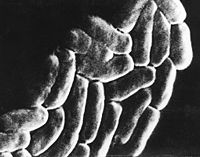Bordetella pertussis
For the course duration, the article is closed to outside editing. Of course you can always leave comments on the discussion page. The anticipated date of course completion is May 21, 2009. One month after that date at the latest, this notice shall be removed. Besides, many other Citizendium articles welcome your collaboration! |
Classification
| Klebsiella pnemoniae | ||||||||||||||
|---|---|---|---|---|---|---|---|---|---|---|---|---|---|---|
 | ||||||||||||||
| Scientific classification | ||||||||||||||
| ||||||||||||||
| Binomial name | ||||||||||||||
| Pseudomonas putida |
Kingdom: Bacteria
Phylum: Proteobacteria
Class: Betaproteobacteria
Order: Burkholderiales
Family: Alcaligenaceae
Genus: Bordetella
Species: B. pertussis
Description and Significance
Bordetella pertusis, commonly known as whooping cough, was first defined in the 16th century. It is a respiratory tract infection depicted by a paroxysmal cough. Bordetella pertusis is extremely tiny, and is a Gram-negative aerobic coccobacilius. It can appear in singles or in pairs. Before vaccinations were prevalent, Bordetella pertusis was a major cause of death among children and infants. After the pertusis vaccine was introduced, reported cases of this infection decreased by more than 99%. Even though this infection has been contained for the most part, it is still remains a disease that is of major concern.
Ecology
Humans are the only home for Bordetella pertusis. Through aerosolized droplets from coughing, Bordetella pertusis is spread. The pathogen is contagious and can be transferred from person to person through these droplets by sneezing or coughing. This gram-negative pleomorphic bacillius attaches to and damages ciliated respiratory epithelium. Its main residence is within the trachea and the bronchi. The pathogen will cease to exist in the environment if it is not embedded in the respiratory mucus of the host.
Genome Structure
Tomaha I, a strain of Bordetella pertusis has its genome completely sequenced. One circular chromosome containing 4.086,189 nucleotides. GC bonds makes up approximately 67% of the genome. The coding density is 82%.
Another genome that is also sequenced from Bordetella pertusis is IncP-1 beta plasmid pBP135. 41,268 base pair nucleotides are contained in this genome. It also carries 46 ORF's. Two of these ORF's have closely resemble genes from a plant pathogen called "Xylella fastidiosa". These genes functions are unknown.
Cell Structure and metabolism
Being an aerobe, Bordetella pertusis uses aerobic respiration as its metabolism. Its cell structure consists of an inner membrane, outer membrane, and periplasmic space. The periplasmic space contains a thin peptidoglycan wall layer in between it. Lipopolysaccharides reside on the outer membrane. These types of endotoxins are not seen in any other Gram-negative bacteria. The lipopolysaccharides in Bordetella pertusis contain two forms, which differ in there phosphate composition of the lipid region of the lipopolysaccharide. Lipid X is the designation of this unusual lipid, which is usually in the Lipid A form. Lipid X's function is not known.
Pathology
Humans are the only home for Bordetella pertusis. The respiratory disease caused by Bordetella pertusis is known as pertussis. It is highly contagious, especially in the early stages, and consists of violent coughing which is immediately followed by "whooping" sounds during the intake air. Hence, this disease also known as "Whooping Cough". Vomiting is also a symptom of this disease. It also consists of discharge which contain sticky mucus. Other symptoms of pertussis are runny nose, coughing sneezing, and a minor fever.
The whooping cough is due to one of the virulence factors of Bordetella pertusis, adenylate cyclase toxin. (CyaA) CyaA attacks eukaryotic cells by directly moving across the plasma membrane of the target cell. Pertussis toxin is another major virulence factor of Bordetella pertusis. It is a major factor of the respiratory infection, especially in the early stages. Pertussis toxins' main target are the macrophages in the respiratory tract. By doing so, pertussis toxin is able to promote the infection. Another virulence factor Bordetella pertusis that is responsible for cell adhesion to host cells is filamentous hemagglutinin.